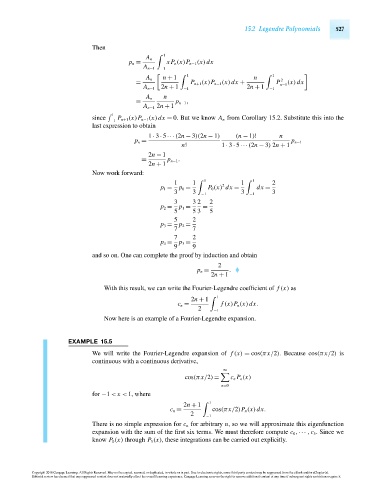Page 547 - Advanced_Engineering_Mathematics o'neil
P. 547
15.2 Legendre Polynomials 527
Then
1
A n
p n = xP n (x)P n−1 (x)dx
A n−1 −1
1 1
A n n + 1 n 2
= P n+1 (x)P n−1 (x)dx + P n−1 (x)dx
A n−1 2n + 1 −1 2n + 1 −1
n
A n
= p n−1 ,
A n−1 2n + 1
1
since P n+1 (x)P n−1 (x)dx = 0. But we know A n from Corollary 15.2. Substitute this into the
−1
last expression to obtain
1 · 3 · 5···(2n − 3)(2n − 1) (n − 1)! n
p n = p n−1
n! 1 · 3 · 5···(2n − 3) 2n + 1
2n − 1
= p n−1 .
2n + 1
Now work forward:
1 1 1 1 1 2
2
p 1 = p 0 = P 0 (x) dx = dx =
3 3 −1 3 −1 3
3 3 2 2
p 2 = p 1 = =
5 5 3 5
5 2
p 3 = p 2 =
7 7
7 2
p 4 = p 3 =
9 9
and so on. One can complete the proof by induction and obtain
2
p n = .
2n + 1
With this result, we can write the Fourier-Legendre coefficient of f (x) as
2n + 1 1
c n = f (x)P n (x)dx.
2 −1
Now here is an example of a Fourier-Legendre expansion.
EXAMPLE 15.5
We will write the Fourier-Legendre expansion of f (x) = cos(πx/2). Because cos(πx/2) is
continuous with a continuous derivative,
∞
cos(πx/2) = c n P n (x)
n=0
for −1 < x < 1, where
2n + 1 1
c n = cos(πx/2)P n (x)dx.
2 −1
There is no simple expression for c n for arbitrary n, so we will approximate this eigenfunction
expansion with the sum of the first six terms. We must therefore compute c 0 ,··· ,c 5 . Since we
know P 0 (x) through P 5 (x), these integrations can be carried out explicitly.
Copyright 2010 Cengage Learning. All Rights Reserved. May not be copied, scanned, or duplicated, in whole or in part. Due to electronic rights, some third party content may be suppressed from the eBook and/or eChapter(s).
Editorial review has deemed that any suppressed content does not materially affect the overall learning experience. Cengage Learning reserves the right to remove additional content at any time if subsequent rights restrictions require it.
October 14, 2010 15:20 THM/NEIL Page-527 27410_15_ch15_p505-562

